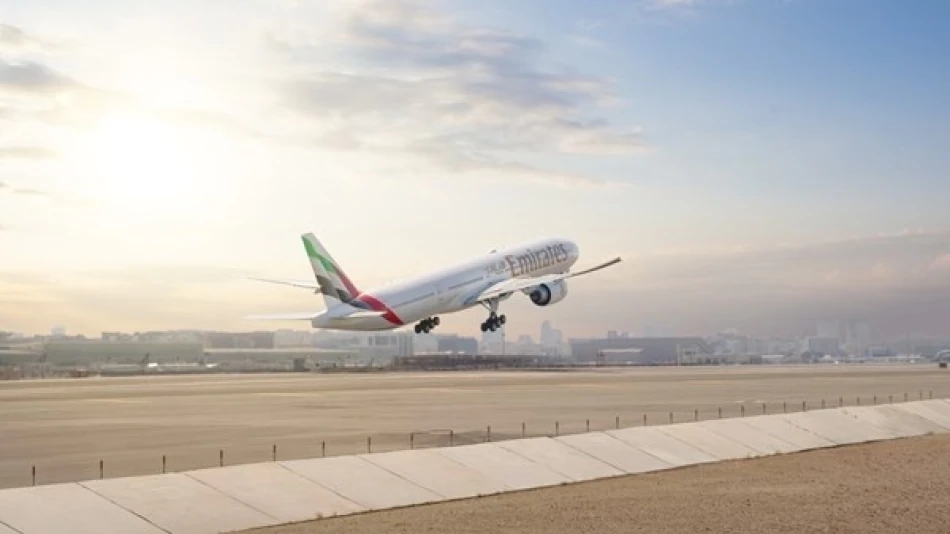
Emirates Resumes Flights to Damascus as Tourism Recovers in Syria
Emirates Airlines Returns to Damascus: A Strategic Bet on Syria's Recovery
Emirates Airlines has officially resumed flights to Damascus after a 12-year suspension, marking a significant vote of confidence in Syria's economic recovery and the UAE's deepening regional influence. The world's largest international carrier reconnected Syria's capital to over 150 destinations across six continents, with plans to scale up to daily flights by October—a timeline that suggests strong demand expectations.
High-Level Diplomatic Signal
The inaugural flight EK 913 carried 286 passengers and a heavyweight delegation that underscored the strategic importance of this route resumption. UAE Sports Minister Dr. Ahmed bin Abdullah Hamid Balhoul Al Falasi led the delegation, accompanied by senior Emirates executives including Adel Al Redha, Deputy President and Chief Operating Officer, and multiple vice presidents across operations, commercial affairs, and airport services.
The presence of UAE aviation authority officials and Dubai police security representatives highlighted the comprehensive coordination required to restart operations in a market that has been isolated from major international carriers since 2012.
Market Recovery Strategy
Emirates' phased approach reveals calculated optimism about Syria's aviation market potential. Starting with three weekly flights on Mondays, Wednesdays, and Sundays, the airline plans to increase frequency to four weekly flights from August 2, before scaling to daily service by October 26.
This gradual expansion mirrors Emirates' strategy in other recovering markets, allowing the carrier to gauge demand while managing operational risks. The partnership with budget carrier flydubai through codeshare agreements provides additional flexibility and cost-effective connectivity options for passengers.
Historical Context and Numbers
Emirates first launched Damascus service in 1988 and transported over 2.1 million passengers to and from Syria before suspending operations in 2012 due to the civil war. The 12-year gap represents one of the longest route suspensions in the airline's history, making this resumption particularly significant for both Syria's reconnection to global markets and Emirates' regional network completion.
Regional Aviation Dynamics
The Damascus route resumption positions Emirates ahead of other major Middle Eastern carriers in capitalizing on Syria's gradual reintegration into regional commerce. While airlines like Qatar Airways and Turkish Airlines have maintained limited regional connectivity, Emirates' extensive global network offers Syrian travelers and businesses unprecedented access to Asia, Europe, and the Americas via Dubai.
This move also strengthens the UAE's position as the region's primary aviation hub, particularly as Dubai International Airport competes with Istanbul and Doha for transfer traffic. Syria's geographic position makes it a potential gateway for broader Levantine market access.
Investment and Trade Implications
For investors and businesses, Emirates' return signals growing confidence in Syria's economic stability and reconstruction potential. The airline's decision to commit to daily flights within four months suggests internal projections of robust passenger demand, likely driven by diaspora connections, business travel, and eventual tourism recovery.
The route also facilitates cargo operations, crucial for Syria's import-dependent economy and reconstruction efforts. Emirates' cargo capacity could prove vital for Syrian businesses seeking to rebuild international trade relationships and access global supply chains.
Syrian Civil Aviation Authority officials emphasized the "continuous coordination and shared vision" required to restart operations, indicating improved institutional capacity and regulatory alignment with international standards—factors that could encourage other international carriers to follow Emirates' lead.
Broader Regional Implications
Emirates' Damascus return reflects the UAE's broader strategy of economic engagement with previously isolated markets. Similar to the UAE's approach in Afghanistan and other challenging markets, the strategy prioritizes commercial opportunities while maintaining political pragmatism.
The success of this route could influence other Gulf carriers' decisions about Syrian market entry and potentially accelerate Syria's reintegration into regional aviation networks. With Emirates currently operating 194 weekly flights to 14 cities across the Middle East and GCC, Damascus adds a strategically important spoke to this regional network.
 Layla Al Mansoori
Layla Al Mansoori







